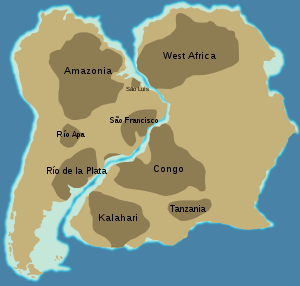
A craton ( /ˈkreɪtɒn/ KRAYT-on, /ˈkrætɒn/ KRAT-on, or /ˈkreɪtən/ KRAY-tən;[1][2][3] from Greek: κράτος kratos "strength") is an old and stable part of the continental lithosphere, which consists of Earth's two topmost layers, the crust and the uppermost mantle. Having often survived cycles of merging and rifting of continents, cratons are generally found in the interiors of tectonic plates; the exceptions occur where geologically recent rifting events have separated cratons and created passive margins along their edges. Cratons are characteristically composed of ancient crystalline basement rock, which may be covered by younger sedimentary rock. They have a thick crust and deep lithospheric roots that extend as much as several hundred kilometres into Earth's mantle.
- ^ "Definition of craton in North American English". Oxford Dictionaries. Archived from the original on 2015-04-02. Retrieved 2015-03-28.
- ^ "Definition of craton in British and Commonwealth English". Oxford Dictionaries. Archived from the original on 2015-04-02. Retrieved 2015-03-28.
- ^ Macquarie Dictionary (5th ed.). Sydney: Macquarie Dictionary Publishers Pty Ltd. 2009.